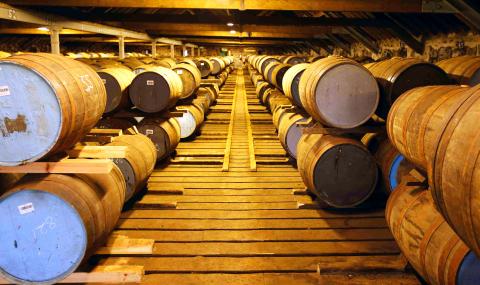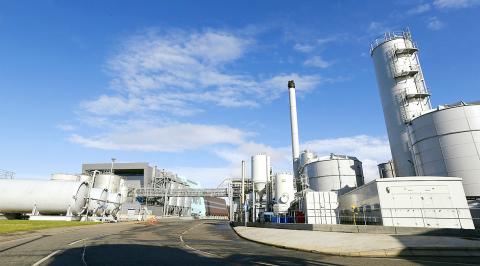Scotch whisky distillers are burning their unwanted grain byproducts, wood chips and other types of biomass for a source of energy in remote areas of the Highlands, where gas links are scarce and fuel oil is pricey.
The production of Scotch whisky has evolved over more than 500 years and is steeped in tradition. It is also a big business, generating £4 billion (US$6 billion) a year in exports — a quarter of all Britain’s food and drink sales abroad.
New distilleries are being built to meet demand from more than 200 countries around the world, including new markets in Asia, Latin America and the Middle East. Family-run, centuries-old distilleries are trying to minimize operational costs.

Photo: Reuters
Most distilleries in Scotland have relied on heavy fuel oil to generate heat for distilling processes, but biomass, such as wood, plant-based material or organic waste, is now an increasingly attractive and reliable option.
“As we expand capacity, biomass will be an integral part of what we are doing going forward,” said Gerry O’Hagan, operational excellence director of spirits and wine for Diageo PLC, the world’s biggest spirits company.
In the whisky-making heartland of Speyside in northeast Scotland, Diageo opened a £45 million distillery four years ago at Roseisle. Barley fields surround the modern industrial building, with glistening glass walls enclosing huge copper stills.

Photo: Reuters
The distillery, which has no access to a gas line, produces 10.5 million liters a year, which is matured for a minimum of three years before being used in brands such as Johnnie Walker.
REDUCED EMISSIONS
Diageo has spent £17 million on a bioenergy plant with a capacity of 8 to 10 megawatts (MW), or enough to power up to 10,000 homes. The distillery gets more than half of its energy from the biomass plant, which also saves about 10,000 tonnes of carbon dioxide emissions a year.

Photo: Reuters
The plant generates energy by burning byproducts of the distilling process such as spent grains, which would otherwise have been sent to farmers for use in animal feed.
The rest of the distillery’s energy comes from burning heavy fuel oil, which is more harmful to the environment and more expensive. Diageo hopes to increase renewable energy to about 80 percent of the plant’s total by mixing its byproducts with wood pellets.
“There is concern about energy [prices] in the long term and about how we can make ourselves as self-sufficient as we possibly can,” O’Hagan said.
Diageo has also installed a bigger, 30MW bioenergy plant at its Cameronbridge distillery near Edinburgh; is building another plant at its Glendullan distillery in Speyside; and has plans for a third at a new malt whisky distillery, also in Speyside.
“There are around 20 new distillery projects at the moment. Some of them are tiny, but around half are in the planning stage, and many of them are asking about biomass,” said Julie Hesketh-Laird, director of operation and technical affairs at the Scottish Whisky Association.
“It makes good business to keep your energy costs down,” she added.
Today’s distillers have to contend with volatile energy and commodity prices; often uncertain barley harvest yields due to more extreme weather patterns; and customers such as supermarkets that are scrutinizing their green credentials.
North Sea oil production is in decline, and the debate around Scottish independence has raised the question of who might control the US$2.5 trillion of reserves, which adds to uncertainty about future oil supply.
“There is a question mark about heavy oil supply and how much there is left. As an industry we don’t look at tomorrow or next week, we are looking at 12, 15 or 20 years down the line,” said Graham Eunson, general manager of the smaller Tomatin distillery.
SMALLER PLAYERS
Smaller, more traditional distilleries must rely on government subsidies to make the economics of biomass work. Under a scheme called the Renewable Heat Incentive (RHI), the government rewards the use of renewable energy technology.
Remote Tomatin, 315m above sea level on the eastern edge of the Monadhliath Mountains, produces 2.5 million liters a year. Two-thirds of its more than 40-strong work force live in housing on its 57-hectare estate.
The plant is one of the oldest distilleries in Scotland, with whisky thought to have been made at the site as early as the 16th century. However, it has experienced troubled times, going into liquidation in the 1980s before being bought by Japanese sake maker Takara Shuzo Co.
Tomatin, which has no gas links, had relied on fuel oil until last year, when it installed a 4MW biomass boiler that burns wood pellets.
“To make that sort of investment on an unknown fuel source is a gamble. It is still perceived as a risk, because if it doesn’t work, it’s an expensive mistake,” Eunson said.
“When we learnt we could get RHI payments, it was a key driver. As much as would love to be the most environmentally friendly firm, if the price of production [from biomass] is twice as high, it would put us at a huge disadvantage,” he said.
Biomass has now replaced 82 percent of the fuel oil it would have used, and Tomatin has cut its annual fuel costs by a third.
Furthermore, “if something happens which impacts the oil price, we are now safeguarded from that to a certain extent,” Eunson said.

A proposed 100 percent tariff on chip imports announced by US President Donald Trump could shift more of Taiwan’s semiconductor production overseas, a Taiwan Institute of Economic Research (TIER) researcher said yesterday. Trump’s tariff policy will accelerate the global semiconductor industry’s pace to establish roots in the US, leading to higher supply chain costs and ultimately raising prices of consumer electronics and creating uncertainty for future market demand, Arisa Liu (劉佩真) at the institute’s Taiwan Industry Economics Database said in a telephone interview. Trump’s move signals his intention to "restore the glory of the US semiconductor industry," Liu noted, saying that

On Ireland’s blustery western seaboard, researchers are gleefully flying giant kites — not for fun, but in the hope of generating renewable electricity and sparking a “revolution” in wind energy. “We use a kite to capture the wind and a generator at the bottom of it that captures the power,” said Padraic Doherty of Kitepower, the Dutch firm behind the venture. At its test site in operation since September 2023 near the small town of Bangor Erris, the team transports the vast 60-square-meter kite from a hangar across the lunar-like bogland to a generator. The kite is then attached by a

Foxconn Technology Co (鴻準精密), a metal casing supplier owned by Hon Hai Precision Industry Co (鴻海精密), yesterday announced plans to invest US$1 billion in the US over the next decade as part of its business transformation strategy. The Apple Inc supplier said in a statement that its board approved the investment on Thursday, as part of a transformation strategy focused on precision mold development, smart manufacturing, robotics and advanced automation. The strategy would have a strong emphasis on artificial intelligence (AI), the company added. The company said it aims to build a flexible, intelligent production ecosystem to boost competitiveness and sustainability. Foxconn

Leading Taiwanese bicycle brands Giant Manufacturing Co (巨大機械) and Merida Industry Co (美利達工業) on Sunday said that they have adopted measures to mitigate the impact of the tariff policies of US President Donald Trump’s administration. The US announced at the beginning of this month that it would impose a 20 percent tariff on imported goods made in Taiwan, effective on Thursday last week. The tariff would be added to other pre-existing most-favored-nation duties and industry-specific trade remedy levy, which would bring the overall tariff on Taiwan-made bicycles to between 25.5 percent and 31 percent. However, Giant did not seem too perturbed by the